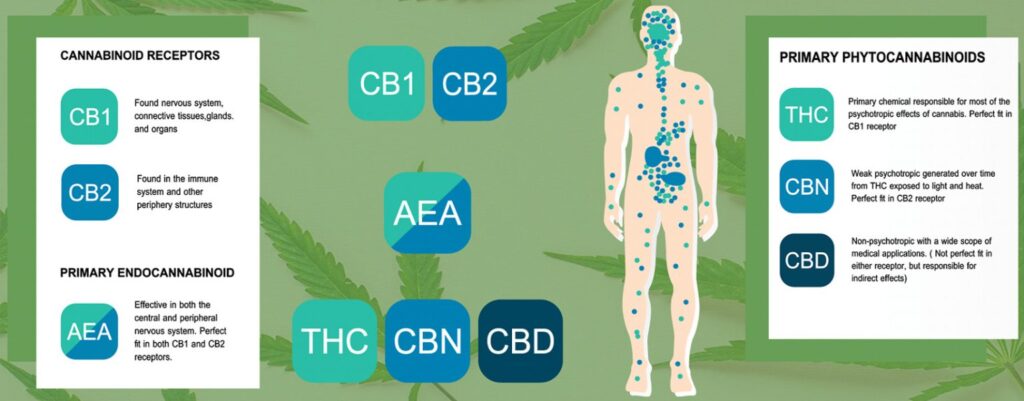
The Endocannabinoid System: All Mammals Have It including YOU!
Cannabis + The Endocannabinoid System. These two things go together like chocolate and peanut butter.
How might you ask?
Well for one thing the “high” you get from cannabis is due to its ability to interact with this physiological system in your body called the endocannabinoid system.
What is the endocannabinoid system?
The endocannabinoid system is found in all humans. Actually, to be more precise, it has been found in all mammals including birds, dogs, and fish, as well as all invertebrates from mussels to sea urchins!
Weird right?
Why would sea urchins and mussels also have an endocannabinoid system?
Turns out the endocannabinoid system does a lot more than facilitate your ability to experience the psychoactive effects of cannabis (which makes sense given that sea urchins aren’t necessarily interested in the psychoactive effects of cannabis … at least not that we know of!).
What does the endocannabinoid system do?
Scientists describe the endocannabinoid system – which interacts with the molecules in the cannabis plant – as the “master regulator” in the body. Regulating functions of immune responses, inflammation, epilepsy, brain regulation, and overall health and well-being.
The endocannabinoid system (also known as the ECS) helps maintain balance and homeostasis regulation in humans, fish, dogs, and even those little sea urchins and mussels.
Internal homeostasis is needed for a body to operate at its highest performance level. As a homeostatic regulator for your body, the endocannabinoid system regulates everything from your immune system to your nervous and cardiovascular system.
This physiologic system is found throughout our entire body, from our brains and organs to our connective tissues, skin cells, glands, and immune cells, and is made up of three main elements:
Cannabinoid receptor
Cannabinoid receptors are present throughout our body, effectively interacting with endocannabinoids and cannabinoids found in the cannabis plant (more on this later).
There are two known cannabinoid receptor types:
CB1 is located primarily in our nervous system and connective tissues. These regulate a whole host of brain functions and also neurotransmitters like dopamine and serotonin found in our brains
CB2 receptors are located primarily in our immune systems. These receptors regulate the homeostasis of immune functions and inflammation.
Endocannabinoids
Endocannabinoids are internally created cannabinoids that our bodies naturally produce and which interact with our cannabinoid receptors. The main endocannabinoids we produce are 2-AG (2-arachidonoylglycerol) and anandamide (also known as the ‘bliss molecule’).
Enzymes
These degrade and break down endocannabinoids. They include the fatty acid amide hydrolase (FAAH) and monoacylglycerol lipase (MAGL).
The endocannabinoid system has been described by scientists as literally a “bridge between body and mind” and helps us start to understand how our brains are connected to our physical health and well-being.
How does cannabis interact with our endocannabinoid system?
What has become clear in the last few decades of research is that cannabis does a lot more than just get you high.
The cannabis plant has a profound influence on the human body by producing substances that interact with our endocannabinoid receptors. These plant molecules are called:
Phytocannabinoids
There are over 100 cannabinoids discovered to date in the cannabis plant. The most prevalent, well known, and most researched cannabinoids are:
THC (Delta 9 tetrahydrocannabinol) This is known as the psychoactive cannabinoid.
CBD (cannabidiol) This is known as the non-psychoactive cannabinoid.
Phytocannabinoids, similar to the endocannabinoids we produce within our bodies, fit like a lock and key into our pre-existing endocannabinoid receptors, engaging with these receptors and their abilities to regulate homeostasis in our overall health and well-being.
The endocannabinoid system is a “universal regulator”. It is constantly working behind the scenes influencing homeostasis throughout our body (and all mammals’ bodies). It regulates everything from sleep, mood, appetite, memory, reproduction and fertility, metabolism, immune function, and pain regulation.
And just like us and all mammals, our physiological systems long to operate at their highest performance level.
Our shared endocannabinoid systems play a huge role in the maintenance of our health and wellbeing.
